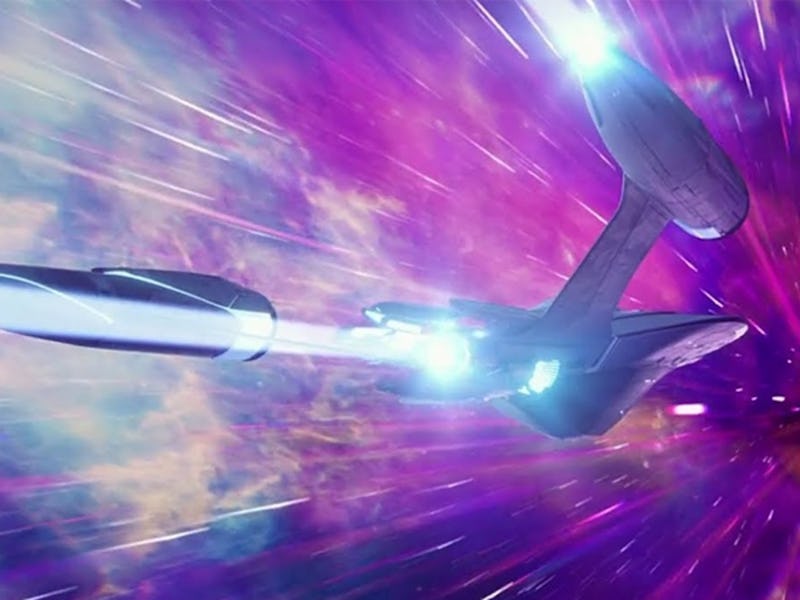Star Trek's Science Advisor Reveals How Starfleet Quietly Fixed Relativity
It’s all about the warp bubbles.

In order for every ship in the Star Trek universe to boldly go, traveling at several times the speed of light is a must. Since before the original Star Trek even debuted, back in its very first pilot episode, “The Cage,” in 1964, Gene Roddenberry struggled with how relativity would work with an interstellar Starfleet. Assuming the Enterprise and other starships traveled at several times the speed of light, wouldn’t that also mean they would be skipping over the regular flow of time? In other words, when everyone in Star Trek warps from planet to planet, they all generally agree that it's the exact same time everywhere. But how?
Einstein’s theory of special relativity tells us that moving through space means alternations in the flow of time, and that time will move differently for those on planets rather than those in space. In the Star Trek universe, this means that the relative ages of Starfleet heroes should be all over the place. But they’re not. And now, after exactly sixty years of the franchise hand-waving this issue, 2024 became the year that Star Trek addressed the warp speed/relativity conundrum. In both Star Trek: Prodigy Season 2 and Star Trek: Discovery Season 5, the Trek universe is getting real about relativity. Inverse caught up with the Star Trek franchise's resident science advisor, astrophysicist Erin Macdonald to get clear answers on how warp drive’s relationship with relativity has finally been addressed.
Star Trek resident science advisor and astrophysicist Dr. Erin Macdonald in 2019, speaking about the importance of STEM education.
“What's great about Warp Drive is it scientifically could work,” Macdonald tells Inverse. “And the reason is that we are limited by the speed of light by traveling on the surface of space-time. So if you think of our universe as a sheet, the heavier you are, you dip it down and then that's harder to travel through. The lighter you are, it's easier. And then if you don't weigh anything, you just coast in a straight line, which is light. What warp drive is it's like, well, nothing says that space-time itself can't go faster than the speed of light.”
This is where things get interesting. In Star Trek: Prodigy, the USS Protostar uses a literal protostar in its core to go even faster than Star Trek’s regular warp drive. The dense gravity of an actual protostar is part of what makes this work, since manipulating gravity — a key player when it comes to time dilation — would be essential if you wanted to avoid the aging effects of relativity during spaceflight.
“We can always bring in relativity and space-time physics. Those are the relativistic aspects that you were talking about. Things like the Twin Paradox,” Macdonald explains. She’s referring to the classic physics problem that states if one twin stayed on Earth and another twin traveled at a speed approaching the speed of light, the second twin would age slower than the first twin, and thus seem younger when meeting the twin still on Earth. So, why isn’t this happening in Star Trek constantly?
Burnham (Sonequa Martin-Green) contemplates the problems of space-time in Discovery Season 5.
“Those problems all happen when you're traveling close to the speed of light, but not when you're doing something like Warp Drive,” Macdonald says. “The idea with Warp is that your ship could barely be moving, it doesn’t have to be moving very fast. And the physics inside your Warp Bubble, you still have a normal sheet of space-time in there. But that has always been a question in Star Trek — like, we have to be messing with time somehow. And it’s true!”
What Erin Macdonald helped the Trek franchise formalize was the idea that the Warp Bubble acts as an insulation from all those relativistic paradoxes. In this year’s Discovery episode “Face the Strange,” Captain Burnham (Sonequa Martin-Green) suggests breaking the Warp Bubble to help out with a time-loop problem. And in this moment — which Erin Macdonald helped write — Burnham says this: “[the warp bubble] is what protects us from the effects of relativity.”
It’s a quick line, but it’s one that hasn’t been uttered quite like that in the Trek franchise, ever.
“I feel like the time nonsense would happen scientifically when you're creating the Warp Bubble, and then when you're dissipating the Warp Bubble,” Macdonald says.
Back in 1964, in “The Cage,” the first Star Trek ever tried to address this question because, at that point, Captain Pike didn’t refer to “warp factors,” but instead, “time warp factors.” In the same pilot episode, a crew member named Tyler, enthusiastically tells aging Earth colonists that the “time barrier” has been broken, acknowledging that the concept of velocity and space-time movement were essentially the same thing. But, after “The Cage,” nobody in Star Trek ever said “time warp factor” again, and the time warp drive of the Enterprise simply became “warp speed.”
The USS Enterprise in “The Cage.”
And yet, the trick of warp is right there in the name — the technological effect is creating a warp in space-time to allow the ship to move in a way that avoids relativity.
“It’s always been in the back of my mind. As a fan, I’ve had that question, but I've also been asked so many times, what about Relativity?” Macdonald reflects. “But we’d never explained it. Until that moment.”